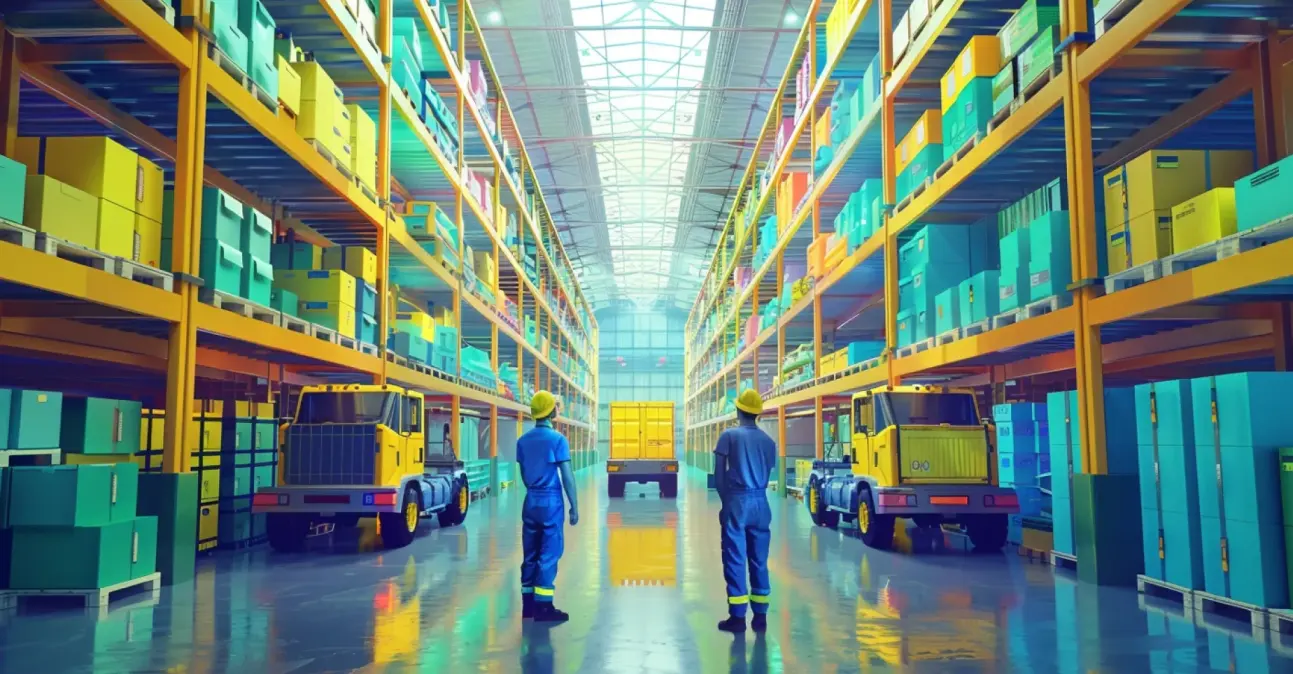Building resilient supply chains using robust warehouse and transportation management systems
Aug 15, 2024 • 5 min read

During the pandemic, many manufacturers encountered sudden demand shifts and supply chain disruptions, affecting everything from raw materials to finished products. And until recently, the Baltimore port incident triggered widespread delays in cargo handling, affecting industries from automotive to retail, and disruptions in the Red Sea have thrown shipping schedules off course, increased transit times, and boosted transportation costs globally. Geopolitical tensions, economic shifts, environmental pressures, and operational hurdles constantly expose weaknesses in traditional supply chains, highlighting the urgent need for businesses to adapt quickly to disruptions.
Supply chain resilience has thus become a key part of business strategy in today’s volatile and unpredictable global market, giving businesses the ability to quickly pivot and maintain operations in such situations. This resilience involves not only contingency planning but also leveraging technology to provide real-time insights and adaptability, ensuring that businesses can continue to meet customer demands despite external challenges. Modern and cutting-edge Warehouse Management Systems (WMS) and Transportation Management Systems (TMS) are essential for building this resilience, allowing businesses to navigate disruptions effectively and maintain smooth operations.
How WMS and TMS support supply chain resilience
WMS and TMS optimize logistics by providing comprehensive control over warehousing and transportation activities, ensuring businesses meet customer demands despite external challenges.
In retail, WMS helps manage complex inventory across multiple locations, optimizing warehouse layout and storage space utilization to ensure accurate stock levels and order fulfillment 1, crucial during peak seasons or unexpected surges in demand, such as during a global pandemic. For example, retailers with robust WMS could more effectively manage the surge in online orders amid the shift in consumer buying patterns during COVID-19.

In the CPG industry, TMS plays a vital role in optimizing transportation logistics, ensuring that goods are transported efficiently from manufacturers to retailers. This includes route planning, load optimization, and real-time tracking, which are essential for managing costs and improving delivery times.

These systems serve as operational tools and strategic assets that enhance a company’s overall resilience. They offer better visibility into supply chains, help anticipate potential disruptions, and enable swift responses to changes, ensuring business continuity in supply chain operations even in the face of supply chain adversities. However, businesses must choose WMS and TMS systems based on their specific technology and business needs to maximize the impact of their investments.
What are the top priorities of WMS and TMS buyers today
Today’s top priorities for WMS, as revealed by the 2024 Gartner Magic Quadrant for WMS 2, include addressing labor challenges and rising costs by investing in innovative solutions that blend traditional labor with automation and AI. Businesses are focusing more on value-added capabilities surrounding core WMS functions, such as workforce management, task interleaving, slotting, yard management, dock scheduling, and performance management. Similarly, TMS buyers also look for solutions that offer comprehensive capabilities like strategic freight sourcing, transportation tracking, and shipment visibility, all available as standalone applications 3. Seamless workflow integration and supply chain optimization across business operations are crucial for enabling end-to-end logistics process orchestration, especially with multiple capabilities at play. The goal is to synchronize WMS data with all other supply chain execution systems, like TMS, and optimize activities around constraints across the entire supply chain.
Cloud-based WMS deployments are becoming increasingly popular due to their cost-effectiveness and ease of maintenance, with more than 80% of new customers preferring cloud if the economics are reasonable 2.
Buyers also seek customizable software that reduces the need for professional services and accelerates implementation times. Consequently, technical architecture, along with vendor and solution viability, total cost of ownership (TCO), and time to value, have become nearly as important as functionality itself. While sophisticated operations require a focus on the breadth and depth of WMS offerings, factors such as simplicity, usability, and cost of ownership are more important in less complex environments.
How can businesses overcome implementation hurdles
Despite these forward-looking expectations, businesses face several challenges with WMS and TMS implementations that can limit their effectiveness. Integrating with other systems, such as ERP and CRM, is often complex, resulting in data silos and inefficient processes. High upfront costs, along with ongoing maintenance and upgrades, can be prohibitive, especially for small to medium-sized businesses. The complexity of these systems necessitates extensive employee training, which can slow down adoption and lead to underutilization.
Data accuracy is another significant challenge—supply chain resilience starts with data. Inaccurate data can lead to poor decision-making, affecting everything from inventory management to transportation scheduling. A robust data governance approach using targeted automation and machine learning ensures data quality and reduces reliance on manual efforts, which are prone to human errors.
While the adoption of cloud-based WMS and TMS is growing rapidly, many companies still rely on on-premises solutions. Many legacy systems, some in place for decades 5, persist in industries slow to transition due to existing investments, unique needs, regulatory or security concerns, as well as the costs and complexities associated with migrating to the cloud. These systems offer control over data and customizability but come with higher upfront costs, require in-house IT support, and lack flexibility and adaptability.
Cloud-based WMS and TMS systems incur lower initial costs, offer scalability, and ease of integration with e-commerce platforms and ERP systems 4. They provide automatic updates, advanced analytics, and real-time data access, which are particularly advantageous in modern, fast-paced environments. As businesses seek to enhance operational efficiency and keep up with technological advancements, working with partners and vendors who can effectively execute their vision on the cloud is crucial for achieving the best return on investment (ROI).
There is a pressing need for cloud modernization, not just to keep up with technology trends but to build a resilient supply chain that can adapt to a rapidly changing market. This modernization effort requires more than simply moving to a new software platform or upgrading to the cloud version of existing on-premises WMS and TMS solutions. It demands a broader strategic effort, including a shift to cloud, modernization of the underlying architecture, and a move to a more modular microservices-based platform with modern front-end technologies.
The next step is to identify areas for improvement by augmenting the human workforce with innovative technologies like artificial intelligence and machine learning. These technologies offer advanced analytics and predictive insights, crucial for proactive decision-making. Implementing real-time data analytics and IoT can further enhance supply chain visibility through continuous data collection and processing, enabling swift responses to disruptions. Finally, focusing on employee training and change management is essential to ensure the workforce can fully utilize modern systems.
Looking forward
As businesses face increasing pressures from global disruptions, the need for advanced, integrated, and scalable logistics solutions becomes critical. By investing in modern WMS and TMS systems, businesses can improve efficiency, reduce costs, and enhance their ability to respond to both expected and unexpected challenges. This transition will require a significant investment of time and resources, but the payoff in terms of resilience and competitiveness makes it a necessary step for any business looking to thrive in the current and future market.
At Grid Dynamics, we’ve successfully led numerous modernization projects, including migrations from on-premises to custom-built cloud solutions. Partnering with industry leaders like Blue Yonder and hyperscalers like AWS, Microsoft Azure, and GCP, we deliver the capabilities businesses need to stay ahead. If you’re looking to futureproof your supply chain using robust and secure WMS and TMS implementations, reach out to us. We can help you prioritize your business needs and achieve a resilient, efficient, and future-ready supply chain.
References
- https://www.logisticsmgmt.com/article/2024_wms_update_at_the_intersection_of_warehousing_and_e_commerce
- https://made4net.com/knowledge-center/gartner-magic-quadrant-WMS/
- https://solutionsreview.com/enterprise-resource-planning/whats-changed-2024-gartner-magic-quadrant-for-transportation-management-systems/
- https://spherewms.com/blog/cloud-wms
- https://www.logisticsmgmt.com/article/2024_wms_update_at_the_intersection_of_warehousing_and_e_commerce
Tags
You might also like

Tariffs, shifting trade policies, and geopolitical instability have slowed new car sales and made consumers more cautious about big-ticket purchases, but the automotive aftermarket continues to surge. With over 2 billion vehicles on the road and rising demand for preventive maintenance, the industr...
The buzzword “composable commerce” has dominated digital strategy conversations since Gartner popularized the term in 2020. But behind the marketing hype lies a longstanding, proven practice of integrating specialized, best-of-breed technology components into a flexible and scalable ecosystem....
In today's fast-paced and data-driven world, accurately predicting demand is more critical than ever for businesses aiming to stay competitive. Traditional forecasting methods often provide a single-point estimate, which can be useful but falls short in accounting for the inherent uncertainties and...

Contract manufacturing involves outsourcing production to third-party manufacturers, which allows companies to focus on core competencies such as design, branding, and distribution. The global contract manufacturing market was valued at USD 246.51 billion in 2022 and is expected to reach USD...
Demand forecasting is a crucial aspect of retail supply chain management that involves predicting future customer demand to make informed decisions about inventory levels, production, and resource allocation. It is a statistical analysis that considers numerous variables to optimize the predict...
In the ever-evolving landscape of transportation, modern Electric Vehicles (EVs) and Hybrid Electric Vehicles (HEVs) have transcended traditional notions of mobility. Beyond mere modes of transportation, these vehicles have emerged as platforms for innovation, where cutting-edge technologies redefi...
Recent sustainability legislations and regulations make due diligence a business imperative for effective supply chain management. Increasingly, regulations and local government bodies are regulating how enterprises must approach, operate, and report on their supply chain operations, both directl...









